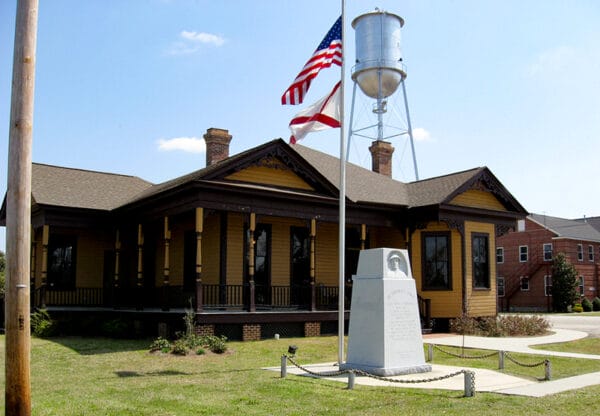Flomaton
 Aerial View of Flomaton, 1929
Flomaton is located in south-central Escambia County, in the southwestern corner of the state. It is situated less than a mile from the Alabama/Florida border. World War I Congressional Medal of Honor winner Sidney E. Manning was a Flomaton resident.
Aerial View of Flomaton, 1929
Flomaton is located in south-central Escambia County, in the southwestern corner of the state. It is situated less than a mile from the Alabama/Florida border. World War I Congressional Medal of Honor winner Sidney E. Manning was a Flomaton resident.
History
The town of Flomaton arose in 1869 at a junction of three railroad lines constructed by the Mobile and Montgomery Railroad. The earliest settler in the area was Hiram Renfroe, a railroad employee. By 1886, the community had 250 residents. The town went by several names, including Reuterville, Whiting, and Pensacola Junction, until April or May 1908, when it was incorporated as Flomaton, a combination of Florida and Alabama, with “-ton” added by the U.S. Postal Service. The town suffered three major fires in the downtown area in 1902, 1908, and 1911; the latter destroyed the Louisville and Nashville Railroad Depot. Flomaton continued as an important rail junction throughout the first half of the century. The timber industry also contributed to the local economy, in particular sawmills, as it still does at present. A major flood in 1929 caused severe damage and was followed quickly by the Great Depression, which further damaged the town’s economy. The Flomaton Gas Field, which produces both oil and natural gas, was discovered in 1968.
Demographics
Flomaton’s population at the time of the 2020 Census was 1,945. Of that number, 58.5 percent identified themselves as white, 36.4 percent as African American, 2.7 percent as Hispanic, 2.3 percent as two or more races, and 1.8 percent as Native American. The city’s median household income was $28,125, and per capita income was $17,828.
Employment
Flomaton’s work force, according to 2020 Census estimates, was divided among the following industrial categories:
- Educational services, and health care and social assistance (36.1 percent)
- Manufacturing (10.8 percent)
- Public administration (9.5 percent)
- Construction (8.0 percent)
- Professional, scientific, management, and administrative and waste management services (6.8 percent)
- Wholesale trade (5.7 percent)
- Retail trade (4.9 percent)
- Other services, except public administration (4.6 percent)
- Agriculture, forestry, fishing and hunting, and extractive (4.4 percent)
- Arts, entertainment, recreation, and accommodation and food services (4.0 percent)
- Finance, insurance, and real estate, rental, and leasing (3.2 percent)
- Transportation and warehousing and utilities (1.9 percent)
Education
Schools in Flomaton are part of the Escambia County School District; the town has one elementary school (K-8) and one high school (9-12).
Transportation
 Flomaton Area Railroad Museum
U.S. Highway 29 runs through Flomaton from the south, where it joins U.S. Highway 31 to run through the city east-west.
Flomaton Area Railroad Museum
U.S. Highway 29 runs through Flomaton from the south, where it joins U.S. Highway 31 to run through the city east-west.
Events and Places of Interest
The Flomaton Natural Area located east of the city has a stand of old-growth longleaf pines, one of the few remaining in the state. The 60-acre tract has been largely untouched for more than 50 years.
The Jackson Theatre, constructed in 1926, is now the home of the Flomaton Antique Auction. The Flomaton Area Railroad Museum recalls Flomaton’s role as an important railroad junction; the museum building also serves as an Alabama welcome center. The Hiram Renfroe log cabin, the oldest structure in town, has been moved from its original location to just behind the Railroad Museum.
Additional Resources
Escambia County Heritage Book Committee. The Heritage of Escambia County, Alabama. Clanton, Ala.: Heritage Publishing Consultants, 2002.
Waters, Annie C. History of Escambia County, Alabama. Huntsville, Ala.: Strode Publishers, 1983.



